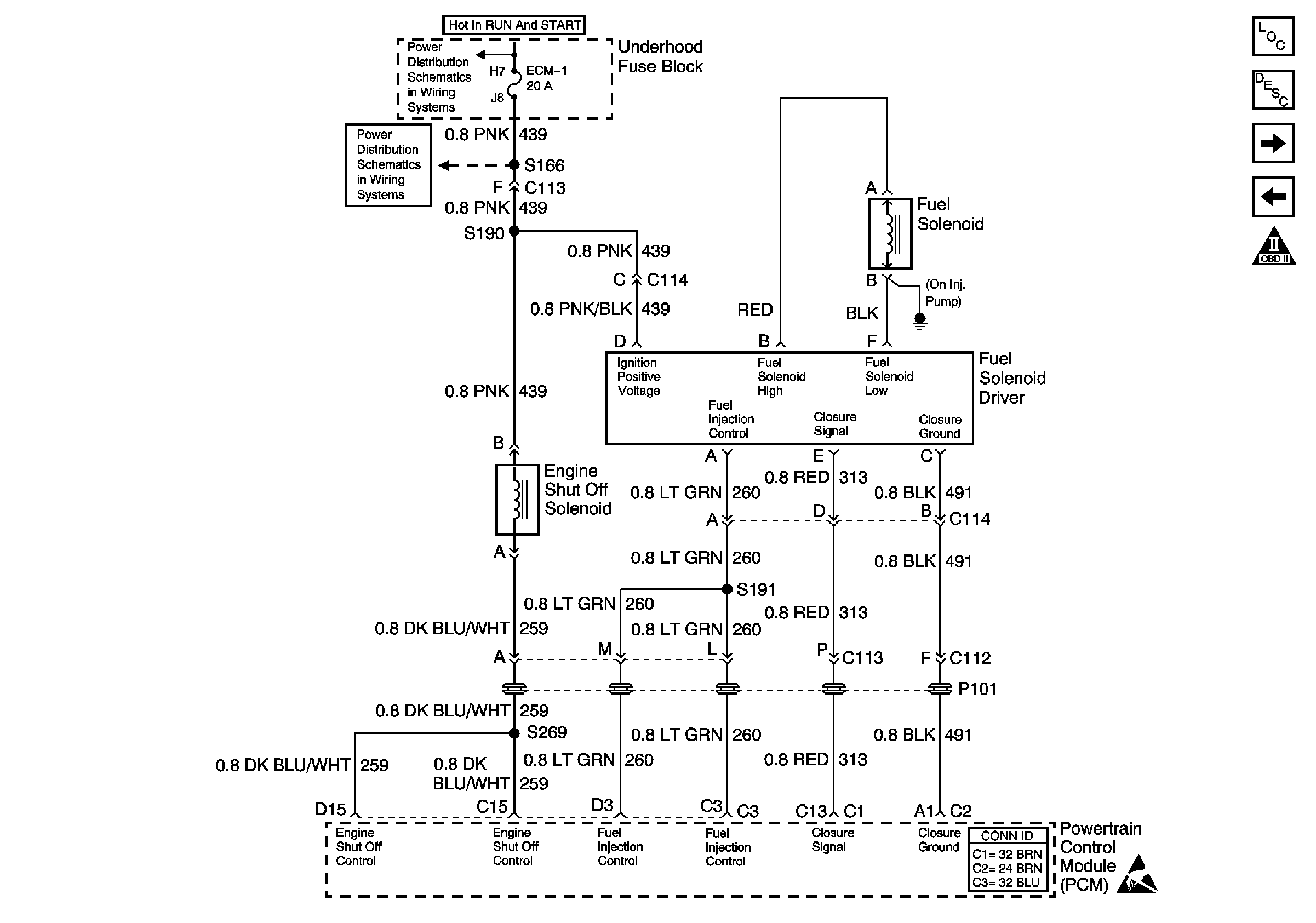Refer to Engine Controls Schematics
Engine Shutoff Solenoid, Fuel Solenoid and Module

.
Circuit Description
The injection pump fuel supply line has a solenoid controlled shutoff located in the injection pump. When the solenoid is energized (key in the run position), the valve is open and fuel is supplied to the injection pump. By providing a ground path, the PCM energizes the solenoid.
Conditions for Running the DTC
The ignition switch in the ON position or the engine is operating.
Conditions for Setting the DTC
| • | The PCM has requested the ESO ON and the control circuit voltage at the PCM is more than 8 volts. |
| • | All of the diagnostic set conditions met for 2 seconds. |
or
| • | The PCM has requested the ESO OFF and the control circuit voltage at the PCM is less than 8 volts. |
| • | All of the diagnostic set conditions met for 2 seconds. |
Action Taken When the DTC Sets
| • | The PCM will not illuminate the malfunction indicator lamp (MIL). |
| • | The PCM records the operating conditions at the time the diagnostic fails. This information will store in the Failure Records. |
Conditions for Clearing the MIL/DTC
| • | A History DTC clears after forty consecutive warm-up cycles, if this or any other emission related diagnostic does not report any failures |
| • | The use of a scan tool. |
Diagnostic Aids
An open in the control circuit or the ignition feed circuit will cause a DTC P0215. Also a no start condition will exist. The scan tool has the ability to turn the engine shutoff solenoid ON and OFF. This can be used as a quick operational check.
An intermittent may be caused by any of the following conditions:
| • | A poor connection |
| • | Rubbed through wire insulation |
| • | A broken wire inside the insulation |
Thoroughly check any circuitry that is suspected of causing the intermittent complaint. Refer to Testing for Electrical Intermittents in Wiring Systems.
If a repair is necessary, then refer to Wiring Repairs or Connector Repairs in Wiring Systems.
Test Description
The numbers below refer to the step numbers on the diagnostic table.
-
This step will check the ESO control circuit for an open.
-
After repairing the circuit for a short to voltage, check the solenoid for proper operation.
Step | Action | Values | Yes | No | ||||
|---|---|---|---|---|---|---|---|---|
1 |
Important: Before clearing the DTCs, use the scan tool Capture Info to save the Freeze Frame and Failure Records for reference. The control modules data is deleted once the Clear Info function is used. Did you perform the Powertrain On-Board Diagnostic (OBD) System Check? | -- | ||||||
2 |
Is the test lamp ON? | -- | ||||||
Is the test lamp ON? | -- | |||||||
4 |
Does the test lamp turn ON and OFF with each command? | -- | ||||||
5 | Check the ESO harness for a proper connection and replace the terminals if necessary. Refer to Wiring Repairs in Wiring Systems. Did any terminal require replacement? | -- | ||||||
6 |
Is the action complete? | -- | -- | |||||
7 |
Is the test lamp ON? | -- | ||||||
8 | Repair the short to ground on the ESO control circuit. Refer to Wiring Repairs in Wiring Systems. Is the action complete? | -- | -- | |||||
9 |
Is the action complete? | -- | ||||||
Is the action complete? | -- | |||||||
11 |
Important: The new injection pump must be timed. Refer to Fuel Injection Pump Timing Adjustment . Replace the injection pump. Refer to Fuel Injection Pump Replacement . Is the action complete? | -- | -- | |||||
12 |
Important: The new PCM must be programmed. Replace the PCM. Refer to Powertrain Control Module Replacement/Programming . Is the action complete? | -- | -- | |||||
13 |
Does the scan tool indicate the diagnostic Passed? | -- | ||||||
14 | Does the scan tool display any additional undiagnosed DTCs? | -- | Go to the applicable DTC | System OK |
